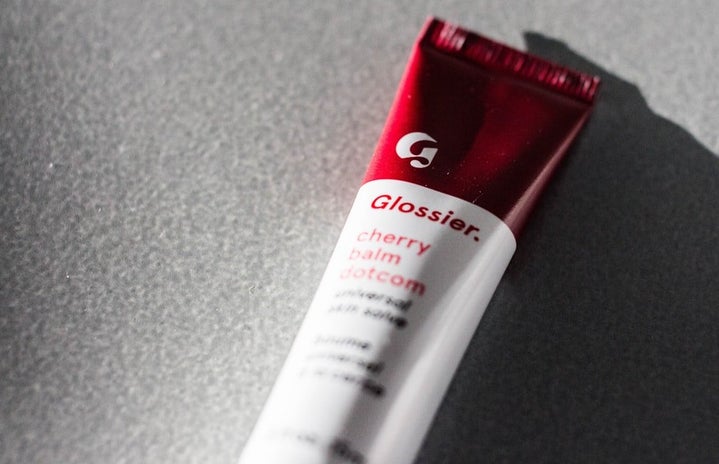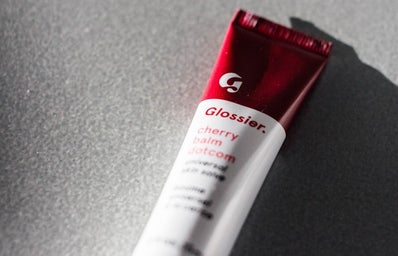It’s me, I’m consumers, and I’m the problem
You can’t miss it. The iconic, sleek packaging set in white and millennial pink with a bold typeface logo seems to be everywhere on social media. Many argue Glossier’s products deserve this hype as they represent a clean, natural definition of beauty that breaks the mold of the camera-ready, flashy and face-tuned makeup trends. But can such a trendy brand really be worth this much anticipation and excitement?
Glossier started as a beauty blog written by founder, Emily Weiss, and quickly turned into a successful makeup, fragrance and skincare brand.For the most part, a lot of the brand’s success is warranted. Glossier products are consistent, stick to a theme and have a mantra that resonates with its target demographic – young women.
In a beauty market that feels very over-saturated with micro-trends, bold colors, filters and influencers, it can be hard to understand why a company that seems to go against all of these arguably successful business models has such a dedicated following.
This success has a lot to do with the aesthetic and lifestyle Glossier leans into. Its products are clean, simple and elegant. Many of their colors and scents work for everyone, and their main purpose is to enhance a user’s natural beauty and make them feel confident in their own skin. Confidence is an idea that is constantly being pushed onto young women, but it’s hard to attain when every other beauty trend tells them to cover up their blemishes, hyper-pigmentation and unique facial features. Glossier emerges as a tool to prove to society and beauty markets that women can be confident and glow from within by enhancing who they truly are.
However, young women don’t necessarily need these products to show off their natural beauty, and Glossier’s push of a “clean-girl aesthetic,” recently popularized by TikTok, has only enhanced the brand’s success in the materialistic world. Not one product—let alone an expensive mascara or lipstick—is going to give users their dream life, but Glossier’s marketing makes customers feel like this lifestyle is attainable by simply using such items.
Additionally, Glossier’s company plays into this almost elite, materialistic idea of life that’s been normalized through social media. It’s one issue to hint that a product will change one’s outlook on life and effortlessly make a customer the best version of themselves, but it’s another to make someone feel like the “out-group” for not adhering to a specific brand. On social media, Glossier acts like a status symbol; influencers using Glossier are thin, beautiful and lead aspirational lives in places like London or New York. But money is needed for these lives – money many aspiring Glossier customers don’t have to spend on new Glossier products. Glossier itself doesn’t necessarily push this agenda, but rather inspires this mindset, since influencers appear under a dewy, pink Glossier spell that they in turn cast onto their audiences.
Even if their products are good, Glossier seems to always push out a new product that feels like a more elevated version of an existing one, whether it be a limited-edition flavor or fancy new packaging. This contributes to the idea that Glossier is exclusive and materialistic, because consumers need to act quickly in order to get these products and stay trendy. Arguably spending money and creating this lifestyle isn’t a priority, but companies like Glossier make it seem like it should be, which can be detrimental to consumers. No one should feel lesser about themselves just because they cannot buy a product that acts as a status symbol.
Nonetheless, Glossier remains a marketing genius by making their products portray this aesthetic. Quickly adapting to the fast-paced content style of TikTok to advertise to Gen-Z and millennials is just another reason why this company sees so much commercial success.
For one thing, they’re creative. On social media, they stay true to their minimalistic, light pink aesthetic but play around with fun, bright flavors for lip balms and packaging. For instance, their lip balms, known as “Balm Dot-Coms,” are quite popular due to their iconic paint tube packaging and bold colors. While at heart Glossier may be more focused on effortless, clean glamor, their lip balms are quite popular with younger audiences because of their playful flavors. Advertising campaigns represent a more carefree, diverse and energetic nature of younger generations. This further increases the demographics that take part in Glossier’s brand identity.
Even though it might seem like the pristine and pastel facade of Glossier has been slightly damaged through analyzing its overall success, it’s hard to deny that Glossier doesn’t deserve at least some of their success. As a consumer, I love their “Balm Dot-Com” and “Cloud Paint” blushes which are pigmented, bright and fun. As a collector, it’s exciting to watch your collection of limited edition and staple balm flavors grow, and their colorful packaging brightens any bag or pocket they’re placed into. Glossier’s aesthetic is impeccable, and one of the reasons customers are drawn to the brand. It’s classy and feminine, and no one can argue against a dresser or nightstand with coordinated, functional products. Plus, their push that “beauty comes from within” is a great message for young women who otherwise receive messages that they need to alter their appearance to be socially acceptable.
All in all, Glossier’s ability to appeal to a variety of audiences and keep up a very specific and sought-after lifestyle and aesthetic is what makes it such a successful brand. Since its beginnings in 2014, Glossier has proven that it is able to adapt to new voices, trends and advertising styles, and I think it’s safe to say they will continue to thrive. Even if it was hard to tell, I do love Glossier products and the brand itself — I mean, just look inside my backpack or makeup bag that is overflowing with their lip balms. Even if they lose some of their grasp on the beauty world, they’ll always have me to pay their employees’ salaries.


